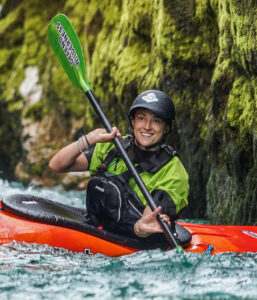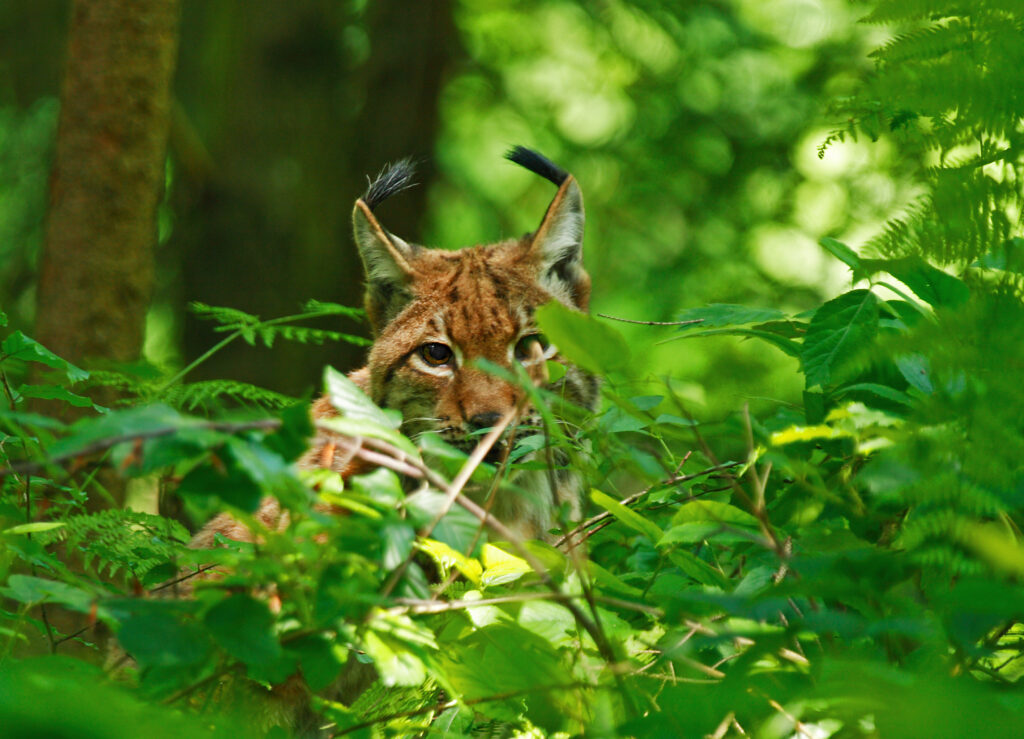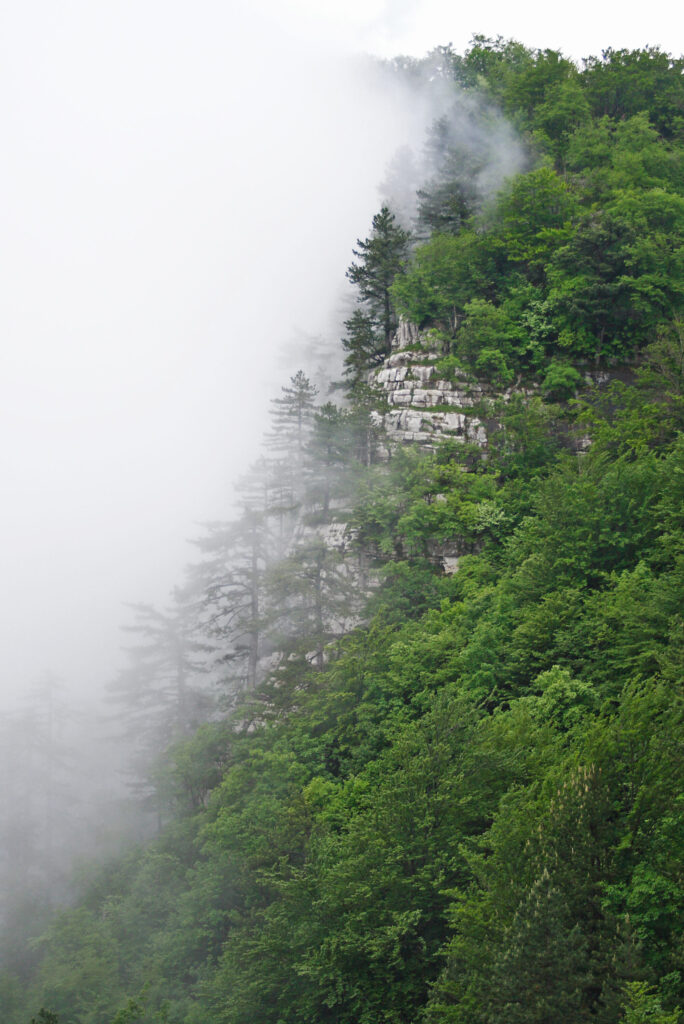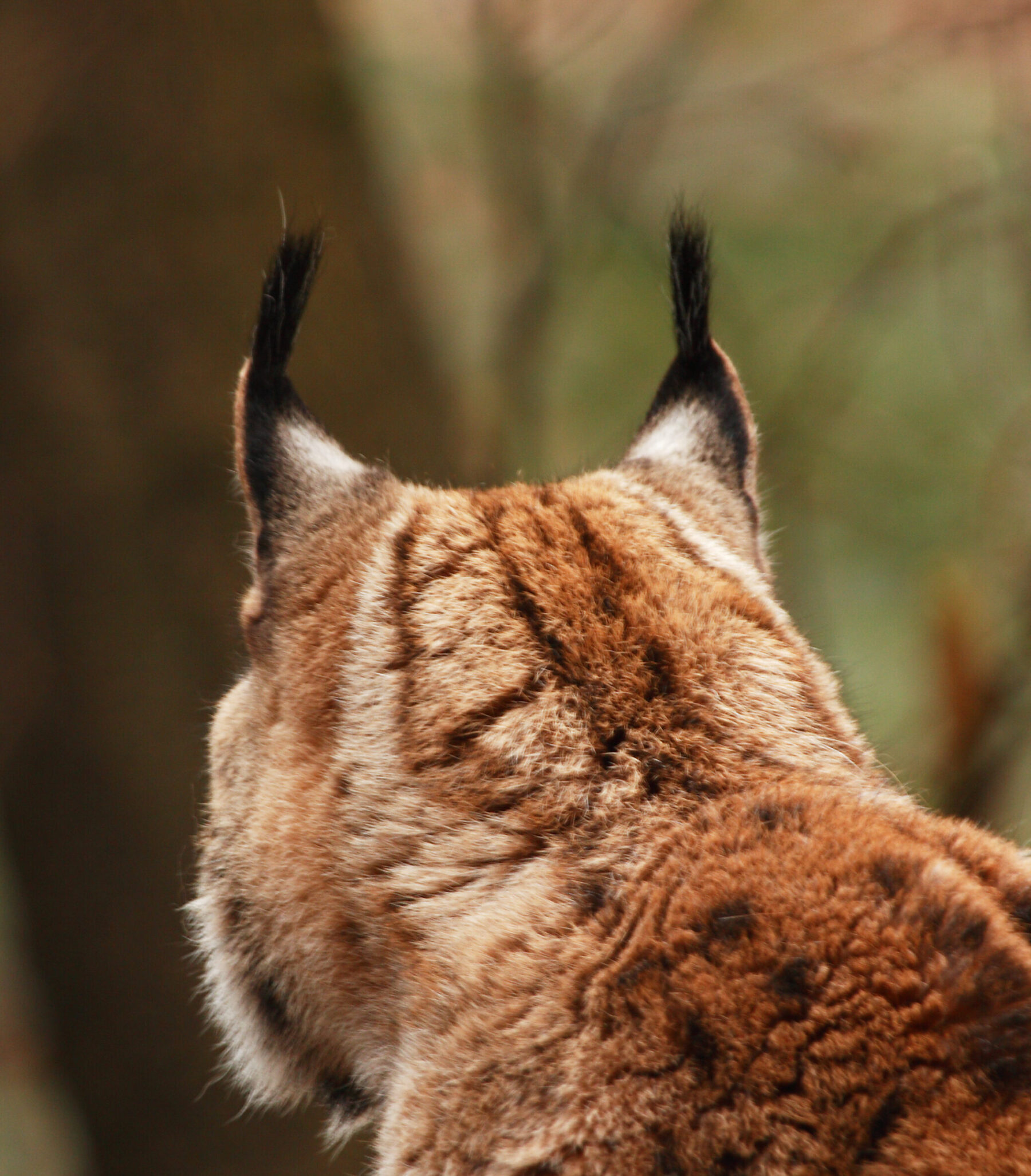
Home Story The Missing Lynx: The Return Of Slovenia’s Big Cat
The Missing Lynx: The Return Of Slovenia’s Big Cat
Feature type Story
Read time 10 mins
Published Mar 24, 2023
Author Carmen Kuntz
Photographer Miha Krofel
Using hiking poles like antennae, we feel our way through the thick beech forest trying to stay on the winding hiking path. It’s pitch black. We chased the setting sun up the mountain road behind our home, catching it at the trailhead, watching the orange orb drop behind the mountains and the last rays of sun reflect off our extended backyard and Slovenia’s Soča River Valley.
An unusual hour for a hike, my boyfriend Rok and I finished work late and decided to spend the night in our sleeping bags under the stars on a local mountain. Rok will fly home in the morning (with the help of his paraglider), and I’ll run down to the car and meet him at home some 1500m below.
We weave around the grey-white karst limestone boulders that are the main ingredient for the Julian Alps, of northwestern Slovenia. After I almost lead us off the trail for a third time, we surrender our night vision and switch on headlights. Scanning the forest for the boisterous dormice that squeak and squeal from the trees in autumn, Rok’s eyes catch the glow of another pair of eyes. A big pair. Too wide-set to be a wild cat or fox. Too close together to be a deer. And they don’t disappear into darkness like a deer or fox would. The eyes flash behind tree trunks, then find a perch above us with a deep karst gulley separating us. They watch us and we watch them. Rok sneaks up the trail and from the side angle of my headlight glow, catches a glimpse of a stubby tail. ‘Carm… I think it’s a lynx!’
In Canada – where I come from – encountering a feline in the mountains is frightful, not exciting. Especially in the dark. The British Columbia backcountry is home to cougars, so my instinct is to make noise; scare it away and keep moving. But Rok once told me that lynx have recently returned to the landscapes of Slovenia, after being extirpated over the 19th century. So, I abandon my Canadian backcountry training and steady my light on the cat, enjoying the jittery feeling inside that comes from being in the presence of such a regal animal. After a few minutes, it slips away, dissolving into the darkness. We walk on in silence and awe.
Two days later, I’m back on the same trail heading to the same spot, this time during daylight. Our friend Tilen Hvala and I hike up the mountain forests, the crunch of fall leaves under foot. We are looking for confirmation that it was indeed a lynx. A trace of hair, or a recent kill could provide proof – but after a day delay due to heavy rain, our chances are even slimmer than usual.
‘It’s very rare to find something,’ says Tilen as we check a wide radius around the karst boulder where the eyes were perched. Tilen is a forester and a local hunter, he said the description and behaviour of the animal we saw is consistent with that of a lynx. A fox or wild cat would have fled immediately. But lynx are curious. ‘It could be passing through the area hunting dormice, but it could be hanging around if it made a larger kill.’
Tilen is employed by the Slovenian Hunting Association but he would never hunt lynx with a rifle, only his camera. ‘Lynx was a species that interested me well before I became a hunter. It’s a very mysterious and charismatic species that only a few people have the privilege to see,’ he tells me. His job is to help a team of researchers monitor and track lynx, while working directly with hunters to educate them on lynx. He also works with the police to improve the prosecution and sanctioning of illegal killing of lynx and other protected wildlife.
‘When I hunt, I feel I am deeply connected with nature and my actions become part of the processes that occur naturally in ecosystems,’ he explains as we walk. ‘Of course, hunting also gives you the ability to bring home the healthiest possible meat, which is highly important to me.’ He is both hunter and conservationist, and while that might seem contradictory, hunters are actually the reason that lynx roam the forests of Slovenia again.
In Canada – where I come from – encountering a feline in the mountains is frightful, not exciting

Mist weaves through the rolling hills of the Dinaric Alps. These dense beech-fir forests host rich communities of mammals, with the lynx, wolf and bear at the top of the food chain.
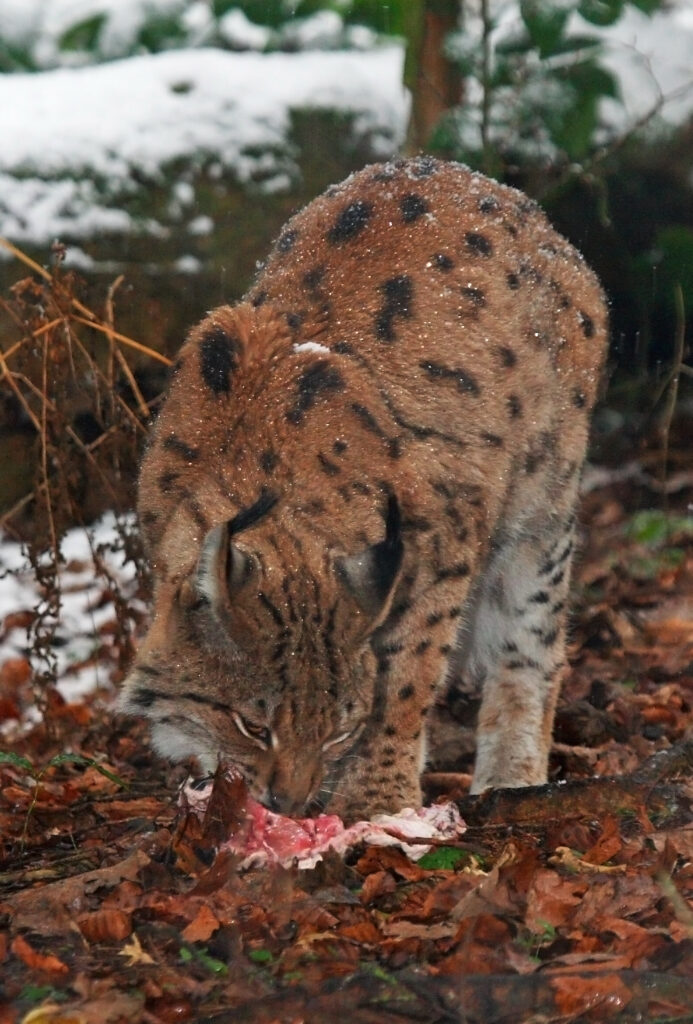
Lynx usually feed on the entire kill of an animal, so it is rare to see a piece of meat devoid of hair, bone and hooves. During translocation, lynx spend time in holding pens – to rest, gain strength and acclimatise – before being released into a new region. This offers researchers a great chance for close up photography of these illusive carnivores.
Hunting is an old and respected tradition in Slovenia. Much like hiking and mountaineering, it has deep roots that go back before Yugoslavia
The Eurasian lynx is a wildcat, easily distinguished by the long tufts of black hair on the tips of its ears, red-brown coat with black spots, long legs, thick webbed paws and…a telltale short tail. The limestone rock formations and thick coniferous and deciduous forests of Slovenia are prime habitat for lynx, who thrive in healthy forests with ample hiding and stalking opportunities. But despite its wide distribution – which can range from most parts of Europe to Central Asia and from Siberia to the Tibetan Plateau – it is threatened by habitat fragmentation and poaching, the reason they disappeared from Slovenia and many other European countries.
Today, Tilen is carrying on an important, and some would think unlikely role of Slovenian hunters, that started in the 1970s when a rare opportunity to bring lynx back to the forests of Slovenia – and ultimately Europe – was pounced upon.
In 1973 Yugoslavia the Slovenian hunter and forester, Maks Konečnik, took a wealthy Swiss hunter, Karl Weber, roe deer hunting in the forests of the Dinaric Alps. Comparable to the Carpathian Mountains in ruggedness, this wild mountain range stretches for over 650km from Italy, through Slovenia and the Balkans all the way to Albania. While trekking through the dense virgin beech and fir forest, Karl commented that these wild forests would have been where lynx once roamed. He then made a bizarre and surprising offer to the local hunter. ‘If you are ready to bring back and settle lynx (in Slovenia), I will finance it.’
Hunting is an old and respected tradition in Slovenia. Much like hiking and mountaineering, it has deep roots that go back before Yugoslavia. The small country is divided into over 400 hunting grounds, each managed by a ‘hunting family.’ Hunters must undergo rigorous training, follow specific rules including attending lectures and carrying out volunteer work each year. In Slovenia, hunters are the protectors of the forests and are directly involved in managing wildlife populations. They allow people and nature to coexist in overlapping landscapes with minimal negative interactions. They ensure Grandma’s garden doesn’t get eaten by an overpopulation of deer, and that corn fields aren’t decimated by wild boar while also ensuring wildlife have the space and resources to thrive in healthy numbers. Sure, hunters also hunt for the meat and any deer or boar that gets shot, gets eaten. ‘We (hunters) are in charge of protecting all indigenous animals,’ said Maks in response to the Swiss hunter’s offer. ‘If we don’t jump on this opportunity, then we are not needed.’
It was a visionary move at the time and true to his word, Karl paid for six Carpathian lynx to be translocated from the Czech Republic to Slovenia in January 1973. Hunters worked with the national forestry institute before, during and after the release, and today the European Union-funded LIFE Lynx project, which Tilen is a project advisor for, is continuing their work.
Tilen and I didn’t find any sign of that late-night lynx. But the sighting provided researchers with valuable information, as this would be the second lynx sighting in this region since the inception of the LIFE Lynx project.
A couple weeks later, I’m in the office of Urša Fležar, a biologist and monitoring expert with the project. We sit down in front of her large computer monitor where GPS points are sprinkled in clusters on a map of Slovenia. Her desk has neat piles of camo-patterned motion sensor cameras; camera traps, the tools of her trade.
Urša has been involved in large carnivore research for over five years. First studying bears, she now manages camera trap monitoring for the LIFE Lynx project, while simultaneously completing her PhD on the effectiveness of camera traps for determining lynx population numbers. And the population in question needs help.
‘The goal of the LIFE Lynx project is to prevent the lynx population in Dinaric Mountains and southeastern Alps from going extinct,’ she tells me. The project has determined that the lynx population created by those six lynx introduced in the 70s is near collapse due to inbreeding. ‘We know we don’t have much time to keep the population genetically healthy,’ she explains. Genetic diversity is increased by introducing new individuals, but also by connecting isolated lynx populations, which in Slovenia means connecting the lynx in the Dinaric Alps with those in the Alps proper. This connection plays a unique role in Eurasian lynx conservation as it is the link between wild populations in the Dinaric Mountains and in the rest of Europe, specifically in Switzerland; connecting the two Slovenian populations basically means creating a corridor between European populations.
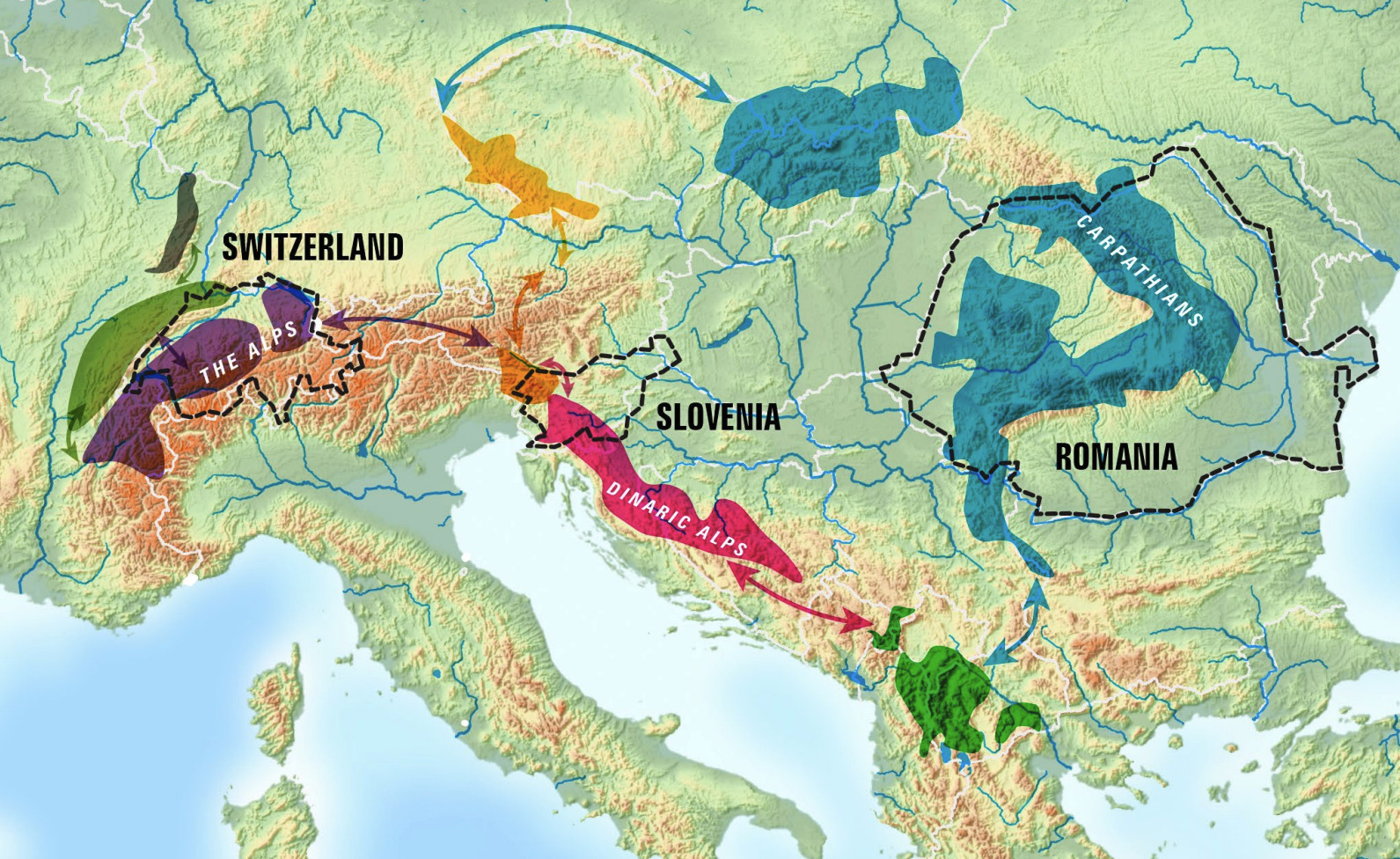
Connecting the two populations of lynx in Slovenia is key to creating a genetic corridor between European populations in the Dinaric Alps and the rest of Europe.
Urša points to a cluster of dots on the map, explaining that each reintroduced lynx has a telemetry (tracking) collar that sends out GPS points daily. She is able to read these points and infer what lynx is up to. ‘Monitoring lynx is very intense and is key to ensure each release is successful,’ Urša says. Tracking collars are integral tools for gathering this information but they are also unreliable. ‘Tracking collars have no geographical limit because they use GPS satellites, but once they stop sending data, we need to rely on other tools to know if the animal is still present in the area or not. Cameras are so important because collars sometimes fail,’ says Urša as she loads her laptop, cameras and batteries into her hiking pack. ‘Cameras are the best available method for population level monitoring of lynx, which is the basis of conservation models and decision-making.
The LIFE Lynx project has over 200 camera traps in Slovenia. Local hunting families check the cameras once a month and email the data to the Slovenian Forest Service. ‘Less than 1% of the photos from our camera traps are of lynx,’ says Urša. Last year the project had approximately 45,000 photos with just over 300 of lynx. The challenge of tracking lynx would be even more daunting without the involvement of hunters.
We leave the office and head for the forest where we will check and repair two camera traps. Urša concisely explains complex concepts as we drive out of Ljubljana and into the mountains of Postojna, a nearby town known for one of the longest karst cave systems in the world. With hiking pants, boots and a cotton t-shirt with a drawing of a lynx, she looks like a hiker. With her vizsla Ruby at her side, she could also be mistaken as a hunter. Ruby is trained to help Urša find kill sites, and the connection the two have as a working relationship is evident as Ruby looks up at Urša, awaiting direction. And interestingly, Ruby is about the same size as an average Eurasian lynx with similar height and weight.
Genetic diversity is increased by introducing new individuals, but also by connecting isolated lynx populations, which in Slovenia means connecting the lynx in the Dinaric Alps with those in the Alps proper
Our first stop is to pick up a local hunter. ‘Building relationships is the biggest challenge of this work,’ she tells me as we pull into his driveway. The relationship between hunters (who are protective of their hunting grounds), and researchers (who will ultimately feed data from those hunting grounds to the government to determine allowable take limits) is fragile and takes time to nurture. ‘We focus on having open communication with hunters and tell them everything we are doing.’ Anytime Urša and Ruby head into the forest, she makes sure that specific hunting family knows. ‘It is so important we don’t lose their trust.’ This relationship and mutual respect is also important when Urša and the team want to share information with hunters about lynx conservation.
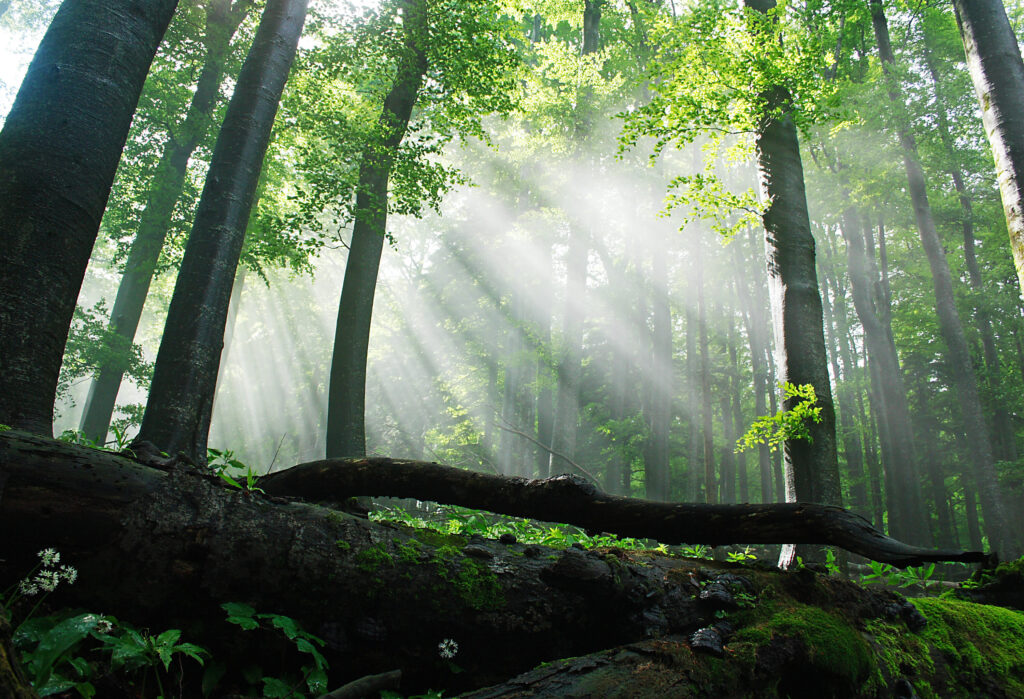
Covered in moss, the deadwood and rocks offer ideal ambush cover for lynx. As a stealth predator, it must approach its prey unnoticed, making as little noise as possible.
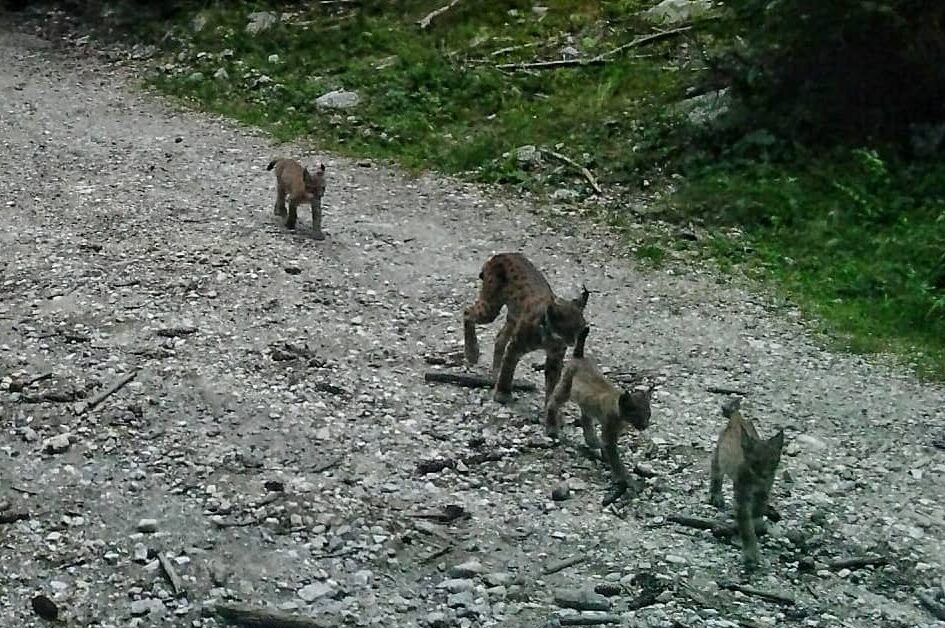
A camera trap captures the first photo of the successful reproduction of lynx in Slovenia’s Triglav National Park after reintroducing five animals to the Alps region of Slovenia in 2021. These kittens represent the beginning of the connection between the lynx in the Dinaric mountains and the Alps. © Lynx LIFE Project
Branko Peternelj slides into the front seat and immediately starts telling Urša stories. He is a slight man, around 70, and has been a hunter his whole life. They chat like old friends as Urša navigates up the forest roads. The laugh lines around Branko’s eyes deepen as he starts another story, his eagerness to share, a clear depiction of his interest in the project. Now on foot, we slide down a steep pitch and arrive at the first camera. Urša’s laptop is open on the ground and Ruby dances around us, kicking leaves onto the keyboard as we flip through images from the camera’s card, revealing a couple of roe deer and a big brown bear, neither of which surprise Branko. The hunting family he belongs to is very open to lynx research and also to using their hunting grounds for other uses, like bear-watching tours. But not everyone is – or was – happy about lynx returning to the forests. In the 70s Maks received threatening letters from other hunters angry that ‘bloodthirsty beasts’ were being reintroduced.
The challenge of tracking lynx would be even more daunting without the involvement of hunters
The LIFE Lynx project has only had a couple of hunting families today refuse to have camera traps on their hunting territory, while others participate the bare minimum. But overall Urša has not had any negative interactions and the project has collaborated with between 40-50 hunting families for the five years of the project.
‘Scientific studies have shown that lynx predation helps keep the environment in balance and keeps deer populations viable,’ says Tilen. ‘In Slovenia, we harmonise the presence of lynx in deer management plans and include the impact of lynx predation in yearly deer cull quotas. This ensures lynx have enough food and there are still deer for hunters to hunt.’
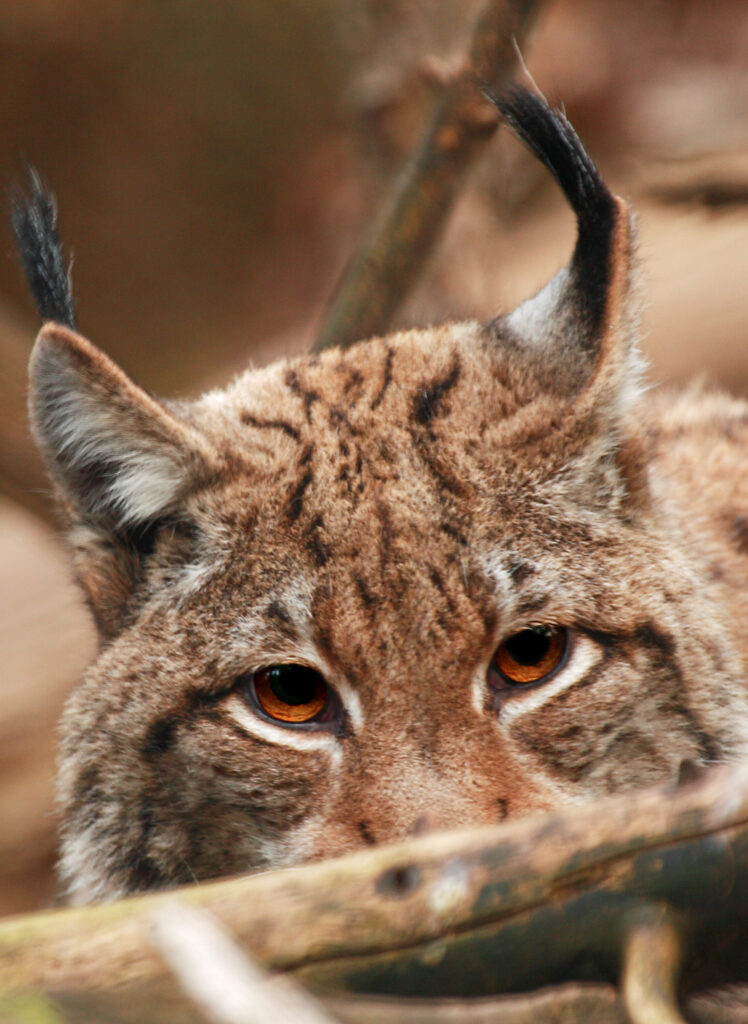
One of the most noticeable characteristics of a lynx are its ear tufts, whose exact function is not yet understood. They are typical for all lynx species worldwide and are a feature that helps us identify the animal in the forest – along with its short, black-tipped tail.
Despite concern around the impact lynx will have on game populations, it could be said that many hunters quietly recognise the privilege of having lynx roam their forests, a rarity not only in Europe but in the world. One hunter in the 70s put it simply; ‘We are confident lynx will do what a man cannot with a rifle.’
En route to check the second camera, we take advantage of an abandoned logging road, and it feels like we are out on a hike, with the soft evening light filtering through the golden beech leaves.
Urša tells me we aren’t the only hikers to have spotted a lynx and share the information with the project. In June 2021, a couple of hikers came across a heap of lynx kittens on the side of a gravel road. They called Urša who recommended they hike on, assuring them that the mother would be back soon and was likely moving the family, one-by-one, from one den to another. This sighting was big news and confirmation of the first reproduction in the Alps from the LIFE Lynx translocated lynx and proof of increasing Slovenian lynx populations. It was also encouraging that the hikers knew where to call to get advice.
Public education is an important element of the LIFE Lynx project, and of successful lynx reintroduction in general. The Lynx Walk is a hiking guide that was created to help people – locals and tourists alike – experience the forest from the perspective of a lynx. It’s a free downloadable document that gives hikers information on lynx ecology, habitats and behaviour and how to recognise typical signs of lynx. ‘It also helps remind people that they are walking through someone’s home,’ says Urša who urges people to stick to trails, and be respectful of the forest.
Coexisting with large carnivores has, and will continue to be, a contested topic. Some see them as an added value, while some see them as a problem. The work Urša, Tilen and Branko are doing requires people from different user-groups and different countries, backgrounds, organisations to work together. A day in the field with a hunter like Branko reminds Urša that they are making progress. ‘It works because we are all working towards the same goal; preserving the lynx,’ she says. And Tilen agrees. ‘Hunters and biologists should not be on two poles but should work together. This (project) offers a tremendous opportunity to bring biologists and hunters closer together and show we have the same interests.’
As we rumble down the forest road, I carefully ask Branko a few questions, cautious not to impede on the delicate relationship Urša has been nurturing with hunters. Using my rudimentary Slovenian, I ask him why he wants lynx back in his home forest and hunting grounds.
‘The forest is complete with lynx in it. That’s why I want lynx back in the forest.’ A simple but very telling answer, and the same reason those Slovenian hunters started this effort back in the 70s. And while that sentiment is not shared by all of Slovenia – or Europe for that matter – the complexities of reintroducing this short-tailed, long-eared cat that humans previously erased from the landscape is reduced to a very simple, almost philosophical idea.
The forest is richer when it’s complete. And that is something hunters, hikers and biologists can all agree on.
Don’t miss a single adventure
Sign up to our free newsletter and get a weekly BASE hit to your inbox
Other posts by this author
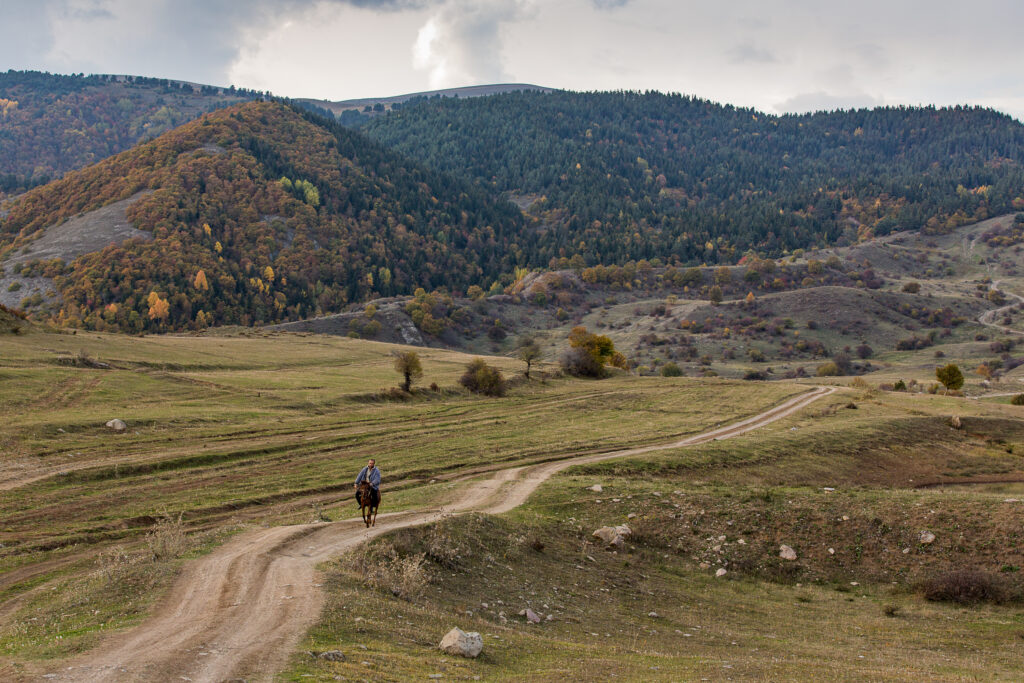
Story • Carmen Kuntz • Mar 06, 2023
How Innovative Nature Conservation Is Making a Big Difference in Armenia
The people behind the ECF project - protecting wildlife and supporting local communities in the South Caucasus
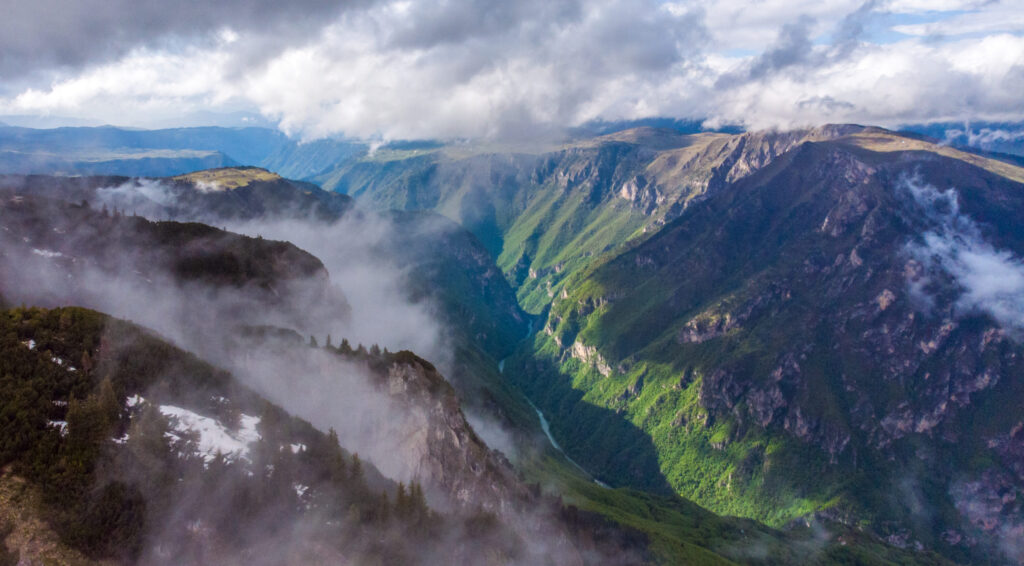
Story • Carmen Kuntz • Nov 30, 2022
Pioneers of Whitewater
The figures behind an adventure tourism movement in southeastern Europe
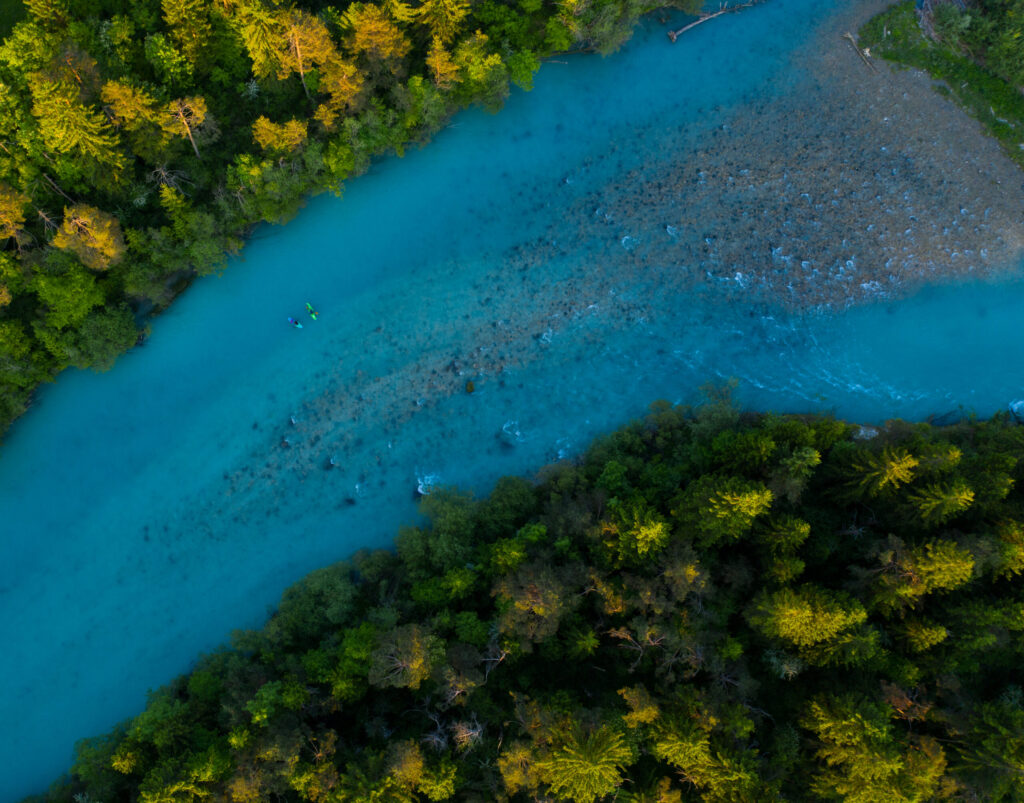
Story • Carmen Kuntz • Feb 18, 2022
One With The River
Whitewater kayaking and environmental action on Slovenia's Sava River
You might also like

Story • Carmen Kuntz • Mar 06, 2023
How Innovative Nature Conservation Is Making a Big Difference in Armenia
The people behind the ECF project - protecting wildlife and supporting local communities in the South Caucasus

Story • Jessie Stevens • Jan 03, 2023
Bikes For Protest: Not a Hero’s Journey
An exploration of bikes as a tool for protest in light of the climate crisis
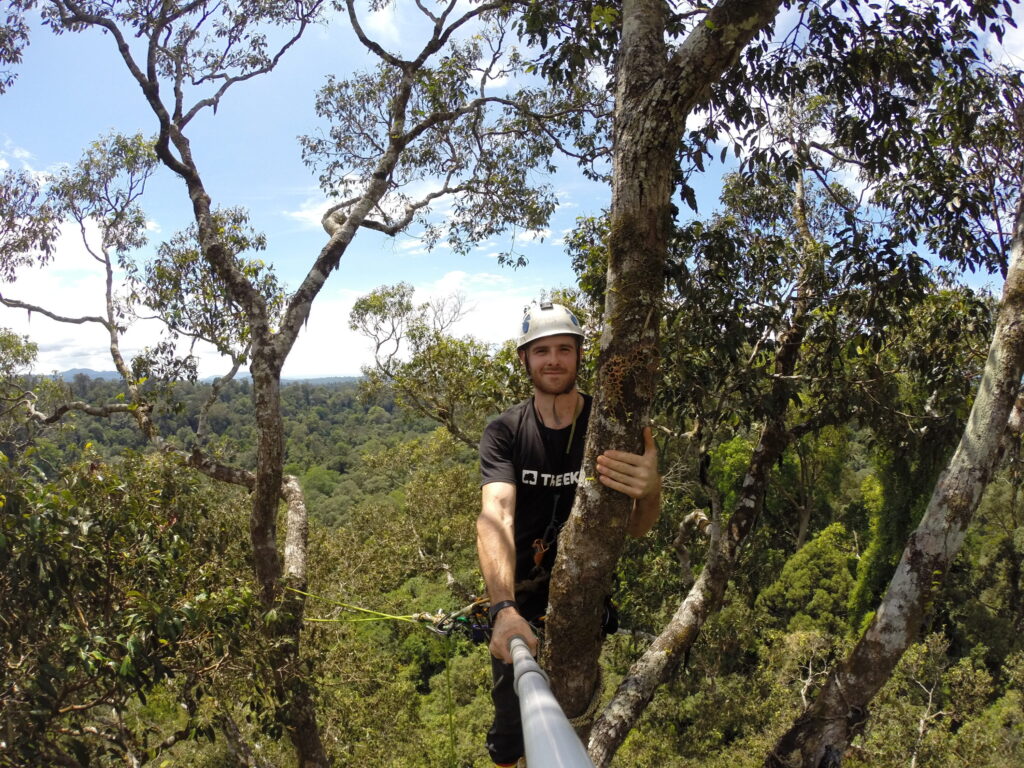
Story • Waldo Etherington • Jan 13, 2022
Lessons From The Canopy
In support of time spent climbing trees
